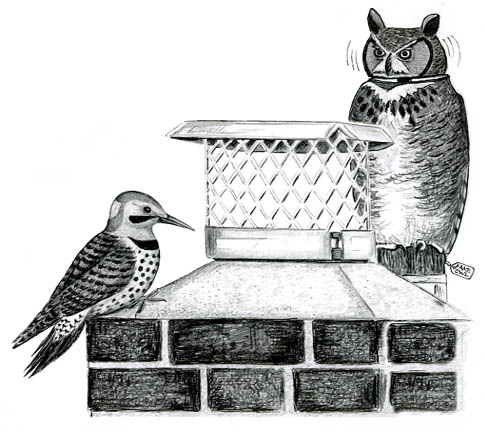
Last week.
In case some of you had something earth shattering to do and missed last week’s column, or if you are like me and can’t remember your own dog’s name, let alone what you read a week ago, let me refresh your memory. Some nice person named “Pat” wrote in wondering why a woodpecker was banging on the side of his/her (Pat’s a tricky name, could be either) house. I talked about the many reasons why woodpeckers attack our homes. They could be looking for bugs, for a mate, or for a place to sleep, or they might have a clapboard fetish. The list of reasons was so long that I ran out of room before I could tell Pat what to do to stop the attacks. The last thing I wrote was that stopping the woodpecker would be “easy” and we would continue next week. Well, after thinking about it, I don’t think the word “easy” is the word I meant to use. What I meant to write is “stopping woodpeckers would be nearly freakin’ impossible.” I must have hit the “easy button” by mistake.
Of all the problems facing modern man only squirrel-proofing and dieting have caused more frustration than deterring woodpeckers. Just as with those other two problems, there have been 156 setbacks in woodpecker-proofing for every success. Over the years we have offered dozens of woodpecker solutions, only to find out later those solutions weren’t really all that helpful, although it’s not really our fault. If someone tells us about some whacky solution that has worked, we feel we should pass it along. And we’ve heard plenty of whacky solutions. One guy told us that he solved his woodpecker problem by cooking baked beans every day for lunch. Why would that help? He claimed that while cooking he would switch on the stove’s exhaust vent and the smell drove the birds away. (We didn’t dare ask which smell he was referring to.) The trouble with the bean theory, as well as many other less-weird suggestions, is they may have appeared to work, when in actuality, the bird could have simply moved away on its own or been eaten by a hawk. The bean fumes may be just an odorous coincidence.
I’ve read hundreds of studies, several from universities, about discouraging woodpeckers and most studies contradict each other. What worked great in one study was totally dissed in another. Apparently birds are like people, some are more sensitive than others. And conversely, some are more stubborn. A cheesy plastic owl may scare one woodpecker into the next state, while another bird may not even notice it. Whether the bird stays or leaves may have to do with natural alternatives. If the offending woodpecker can satisfy its needs, whatever they happen to be, in the nearby woods, it may be happy to move away from the house with the cheesy owl.
What to do? Here are a few points that most studies seem to agree on. At the first sign of a woodpecker assault, get on it. If you hear tapping at sunrise, grab your fuzzy slippers and silk bathrobe, go outside and start yelling. Don’t wait until the crack of 10:30, when you usually get up. The damage will already be done. If you see holes in your shingles, get them fixed. Holes in wood are a “come and get it” signal to a woodpecker. While you are up there fixing the holes, check for insects. They may be the attraction. However, be careful when calling pest control. Bugs or no bugs, some of those guys will spray anything. If insects aren’t the problem, spraying won’t stop the woodpeckers and you’ll be left with a house covered in poison, as well as holes.
One of the most successful and cheapest woodpecker deterrents is holographic tape, sometimes called “scare tape.” Most of the woodpecker studies and our own experiences agree on this. Scare tape is a shiny, reflective 3/4″ strip, that can be cut into any length and hung over the problem area, like the beaded curtains hippies used to use. When the wind blows, the tape’s motion, sound and reflecting colors freak out all but the most stubborn woodpeckers.
If the scare tape doesn’t do the job, or you don’t like the thought of making your house look like a disco in Vegas, the next step is Plexiglas. A thin sheet of Plexiglas, tacked up over the woodpecker’s favorite pecking spot, will prevent the bird from landing by not allowing it to get a grip. Good old Plexiglas: the poor man’s vinyl siding.
The key to deterring woodpeckers is immediate and constant action. People who sit back and turn up the volume on the TV to drown out the sound of the bird’s drumming, will end up with a well-ventilated house. If none of the above suggestions work, Pat, you could always try the baked beans method. If your neighbors complain about the smell, just tell them it’s the dog. That’s what I always do.